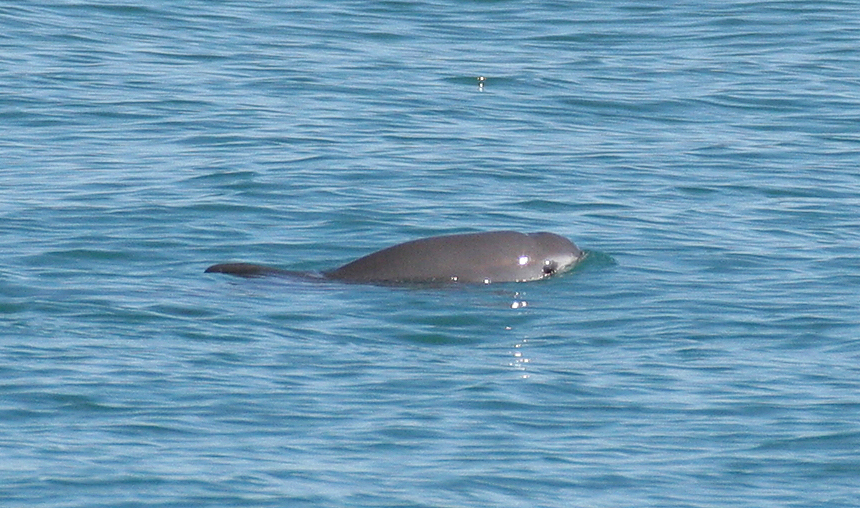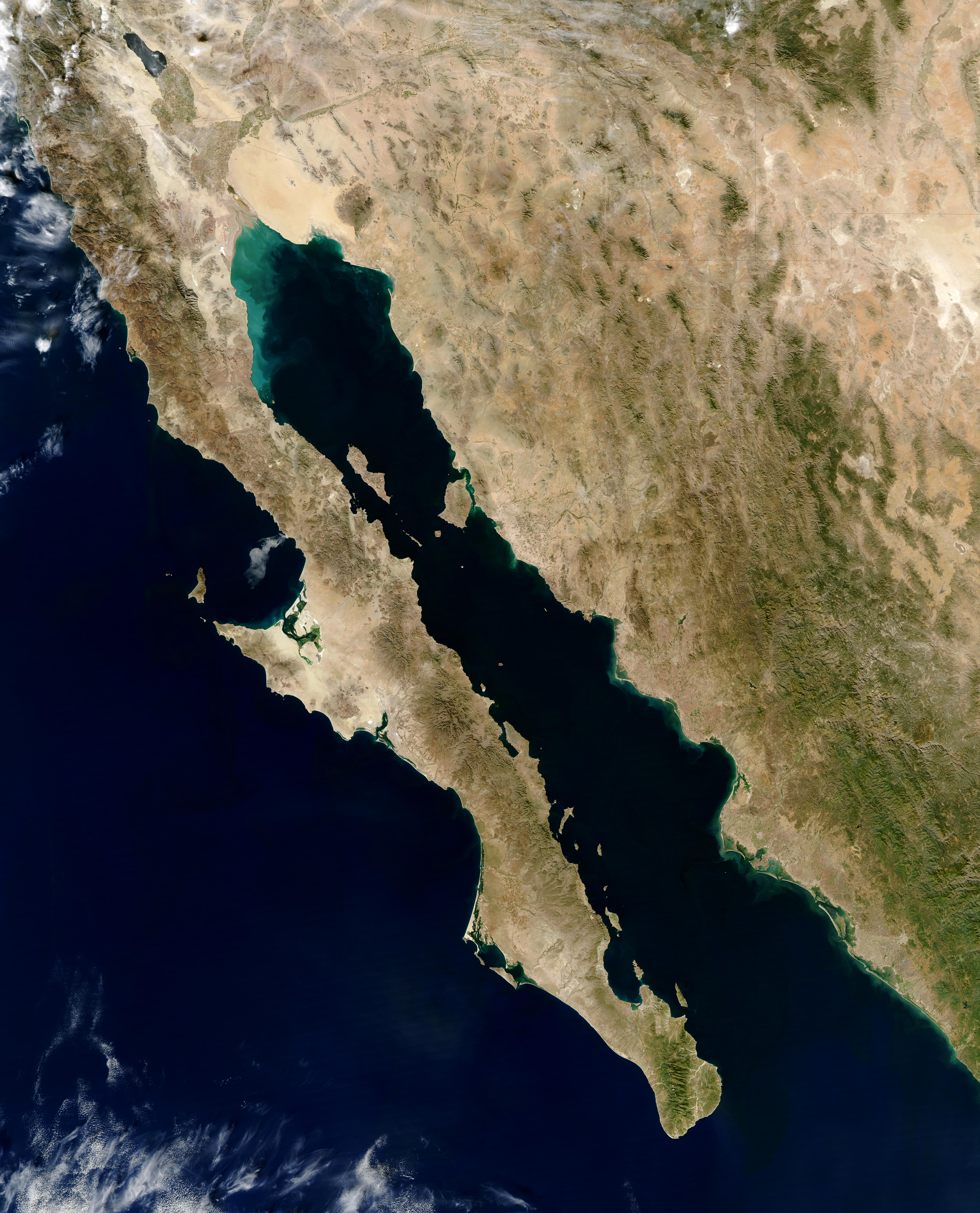|
Vaquita
The vaquita ( ; ''Phocoena sinus'') is a species of porpoise endemic to the northern end of the Gulf of California in Baja California, Mexico. Reaching a maximum body length of (females) or (males), it is the smallest of all living cetaceans. The species is currently on the brink of extinction, and is listed as Critically Endangered by the IUCN Red List; the steep decline in abundance is primarily due to bycatch in gillnets from the illegal totoaba fishery. Taxonomy The vaquita was defined as a species by two zoologists, Kenneth S. Norris and William N. McFarland, in 1958 after studying the morphology of skull specimens found on the beach. It was not until nearly thirty years later, in 1985, that fresh specimens allowed scientists to describe their external appearance fully. The genus ''Phocoena'' comprises four species of porpoise, most of which inhabit coastal waters (the spectacled porpoise is more oceanic). The vaquita is most closely related to Burmeister's porpoi ... [...More Info...] [...Related Items...] OR: [Wikipedia] [Google] [Baidu] |
Porpoise
Porpoises () are small Oceanic dolphin, dolphin-like cetaceans classified under the family Phocoenidae. Although similar in appearance to dolphins, they are more closely related to narwhals and Beluga whale, belugas than to the Oceanic dolphin, true dolphins. There are eight extant species of porpoise, all among the smallest of the toothed whales. Porpoises are distinguished from dolphins by their flattened, spade-shaped teeth distinct from the conical teeth of dolphins, and lack of a pronounced beak, although some dolphins (e.g. Hector's dolphin) also lack a pronounced beak. Porpoises, and other cetaceans, belong to the clade Cetartiodactyla with even-toed ungulates. Porpoises range in size from the vaquita, at in length and in weight, to the Dall's porpoise, at and . Several species exhibit sexual dimorphism in that the females are larger than males. They have streamlined bodies and two limbs that are modified into flippers. Porpoises use Animal echolocation, echolocatio ... [...More Info...] [...Related Items...] OR: [Wikipedia] [Google] [Baidu] |
Totoaba
The totoaba or totuava (''Totoaba macdonaldi'') is a species of marine fish endemic to the Gulf of California in Mexico. It is the largest member of the drum family Sciaenidae and is the only extant species in the genus ''Totoaba''. Originally an abundant species, the totoaba is now considered endangered due to human-related threats that contributed to its population decline. Distribution and habitat Although the totoaba population has declined due to nearly 50 years of overfishing, they have maintained their historical distribution range across the Gulf of California, inhabiting the northern part of the Gulf, the south of La Paz, the west of Baja California Sur, and the east of Mármol, Sinaloa. Interestingly, the genus ''Totoaba'' appears to have had a slightly wider range on the western North American coast in prehistoric times; a fossil otolith assigned to the extinct species '' T. fitchi'' is known from the Oclese Sand Formation in Kern County, California, suggesting tha ... [...More Info...] [...Related Items...] OR: [Wikipedia] [Google] [Baidu] |
Sea Of Cortez
The Gulf of California (), also known as the Sea of Cortés (''Mar de Cortés'') or Sea of Cortez, or less commonly as the Vermilion Sea (''Mar Vermejo''), is a marginal sea of the Pacific Ocean that separates the Baja California peninsula from the Mexican mainland. It is bordered by the states of Baja California, Baja California Sur, Sonora, and Sinaloa with a coastline of approximately . Rivers that flow into the Gulf of California include the Colorado, Fuerte, Mayo, Sinaloa, Sonora, and the Yaqui. The surface of the gulf is about . Maximum depths exceed because of the complex geology, linked to plate tectonics. The gulf is thought to be one of the most diverse seas on Earth and is home to more than 5,000 species of micro-invertebrates. Parts of the Gulf of California are a UNESCO World Heritage Site. Geography History The marine expeditions of Fortún Ximénez, Hernán Cortés, Juan Rodríguez Cabrillo, Francisco de Ulloa, Hernando de Alarcón, Captain Francisco de L ... [...More Info...] [...Related Items...] OR: [Wikipedia] [Google] [Baidu] |
Smallest Organisms
The smallest organisms found on Earth can be determined according to various aspects of organism size, including volume, mass, height, length, or genome size. Given the incomplete nature of scientific knowledge, it is possible that the smallest organism is undiscovered. Furthermore, there is some debate over the definition of life, and what entities qualify as organisms; consequently the smallest known organisms (microrganisms) may be nanobes that can be 20 nanometers long. Microorganisms Obligate endosymbiotic bacteria The genome of '' Nasuia deltocephalinicola'', a symbiont of the European pest leafhopper, '' Macrosteles quadripunctulatus'', consists of a circular chromosome of 112,031 base pairs. The genome of '' Nanoarchaeum equitans'' is 491 Kbp nucleotides long. ''Pelagibacter ubique'' '' Pelagibacter ubique'' is one of the smallest known free-living bacteria, with a length of and an average cell diameter of . They also have the smallest free-living bacterium gen ... [...More Info...] [...Related Items...] OR: [Wikipedia] [Google] [Baidu] |
Spectacled Porpoise
The spectacled porpoise (''Phocoena dioptrica'') is a small to midsize porpoise indigenous to the Southern Ocean. It is one of the most poorly studied cetaceans, partly due to its remote range in the Southern Ocean. What little is known about this porpoise species has been gathered mainly from stranded individuals, and a few observations of living animals made at sea. The species was first described in 1912 by Fernando Lahille. Description As with other porpoise species, the spectacled porpoise has no beak. It has small pectoral fins with rounded tips positioned far forward on the body, and a triangular dorsal fin. This porpoise species shows obvious sexual dimorphism between adult males and females, as the dorsal fins in males are much larger and more rounded than those of females. Records for female length range up to , while males may reach , which represents the largest specimen documented thus far. The maximum weight for a female was , while a male has been recorded a ... [...More Info...] [...Related Items...] OR: [Wikipedia] [Google] [Baidu] |
Cetacea
Cetacea (; , ) is an infraorder of aquatic mammals belonging to the order Artiodactyla that includes whales, dolphins and porpoises. Key characteristics are their fully aquatic lifestyle, streamlined body shape, often large size and exclusively carnivorous diet. They propel themselves through the water with powerful up-and-down movements of their tail, which ends in a paddle-like fluke, using their flipper-shaped forelimbs to steer. While the majority of cetaceans live in marine environments, a small number reside solely in brackish water, brackish or fresh water. Having a cosmopolitan distribution, they can be found in some rivers and all of Earth's oceans, and many species migrate throughout vast ranges with the changing of the seasons. Cetaceans are famous for cetacean intelligence, their high intelligence, complex social behaviour, and the enormous size of some of the group's members. For example, the blue whale reaches a maximum confirmed length of and a weight of 173 tonne ... [...More Info...] [...Related Items...] OR: [Wikipedia] [Google] [Baidu] |
Kenneth S
Kenneth is a given name of Gaelic origin. The name is an Anglicised form of two entirely different Gaelic personal names: ''Cainnech'' and '' Cináed''. The modern Gaelic form of ''Cainnech'' is ''Coinneach''; the name was derived from a byname meaning "handsome", "comely". Etymology The second part of the name ''Cinaed'' is derived either from the Celtic ''*aidhu'', meaning "fire", or else Brittonic ''jʉ:ð'' meaning "lord". People Fictional characters * Kenneth Widmerpool, character in Anthony Powell's novel sequence ''A Dance to the Music of Time'' * Kenneth Parcell from 30 Rock Places In the United States: * Kenneth, Minnesota * Kenneth City, Florida In Scotland: * Inch Kenneth Inch Kenneth () is a small grassy island off the west coast of the Isle of Mull, in Scotland. It is at the entrance of Loch na Keal, to the south of Ulva. It is part of the Loch na Keal National Scenic Area, one of 40 in Scotland. It is within ..., an island off the west coast of th ... [...More Info...] [...Related Items...] OR: [Wikipedia] [Google] [Baidu] |
Demersal Fish
Demersal fish, also known as groundfish, live and feed on or near the bottom of seas or lakes (the demersal zone).Walrond Carl . "Coastal fish - Fish of the open sea floor"Te Ara - the Encyclopedia of New Zealand. Updated 2 March 2009 They occupy the sea floors and lake beds, which usually consist of mud, sand, gravel or rocks. In coastal waters, they are found on or near the continental shelf, and in deep waters, they are found on or near the continental slope or along the continental rise. They are not generally found in the deepest waters, such as abyssal depths or on the abyssal plain, but they can be found around seamounts and islands. The word ''demersal'' comes from the Latin ''demergere'', which means ''to sink''. Demersal fish are bottom feeders. They can be contrasted with pelagic fish, which live and feed away from the bottom in the open water column. Demersal fish fillets contain little fish oil (one to four per cent), whereas pelagic fish can contain up to 30 p ... [...More Info...] [...Related Items...] OR: [Wikipedia] [Google] [Baidu] |
Generalist And Specialist Species
A generalist species is able to thrive in a wide variety of environmental conditions and can make use of a variety of different resources (for example, a heterotroph with a varied diet). A specialist species can thrive only in a narrow range of environmental conditions or has a limited diet. Most organisms do not all fit neatly into either group, however. Some species are highly specialized (the most extreme case being monophagous, eating one specific type of food), others less so, and some can tolerate many different environments. In other words, there is a continuum from highly specialized to broadly generalist species. Description Omnivores are usually generalists. Herbivores are often specialists, but those that eat a variety of plants may be considered generalists. A well-known example of a specialist animal is the monophagous koala, which subsists almost entirely on eucalyptus leaves. The raccoon is a generalist, because it has a natural range that includes most of Nor ... [...More Info...] [...Related Items...] OR: [Wikipedia] [Google] [Baidu] |
Grunt Sculpin
The grunt sculpin or grunt-fish (''Rhamphocottus richardsonii'') is a small fish mainly found in the Pacific Ocean, eastern Pacific Ocean. The grunt sculpin generally remains close to shore and is often found in empty Balanus nubilus, giant barnacle shells. The common name comes from reports that the fish vibrate or "grunt" when held. Its defining feature is its tendency to "hop" along the ocean floor on its orange fins. The short, stout body of the grunt sculpin has a long, small mouth which is adapted for eating smaller prey. Taxonomy It is a member of the class Actinopterygii, the ray-finned fishes. It is further classified into the order Scorpaeniformes, commonly known as the mail-cheeked fishes. The superfamily Cottoidea which is classified within this order includes ''R. richardsonii'' and all other sculpins. However, the grunt sculpin was regarded as the only member of the family Rhamphocottidae until the Ereuniidae was synonymized with Rhamphocottidae. The records from ... [...More Info...] [...Related Items...] OR: [Wikipedia] [Google] [Baidu] |








